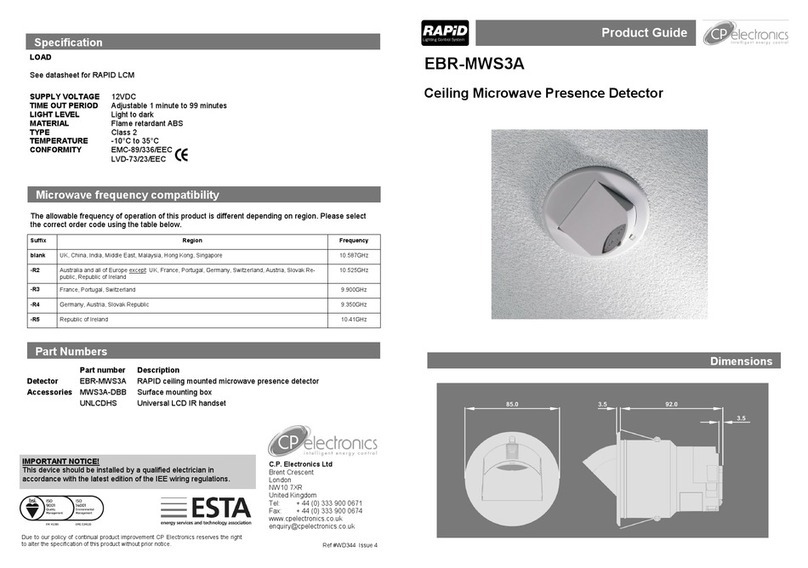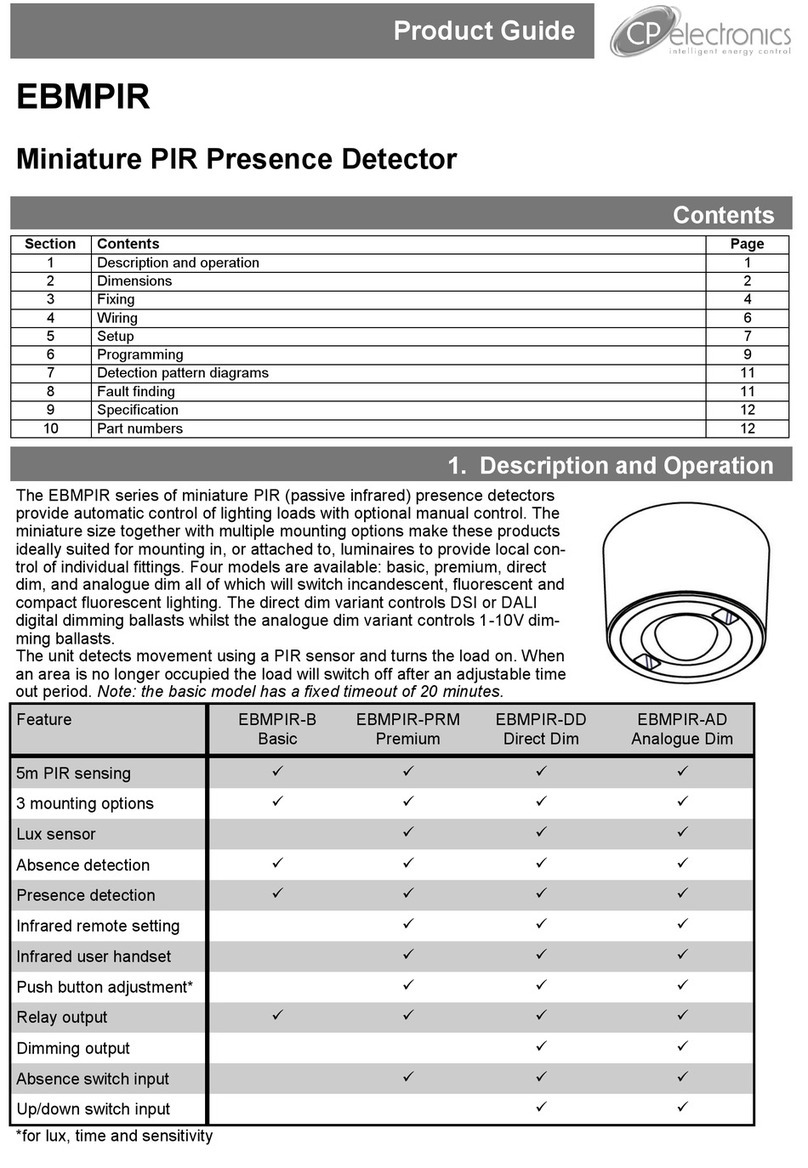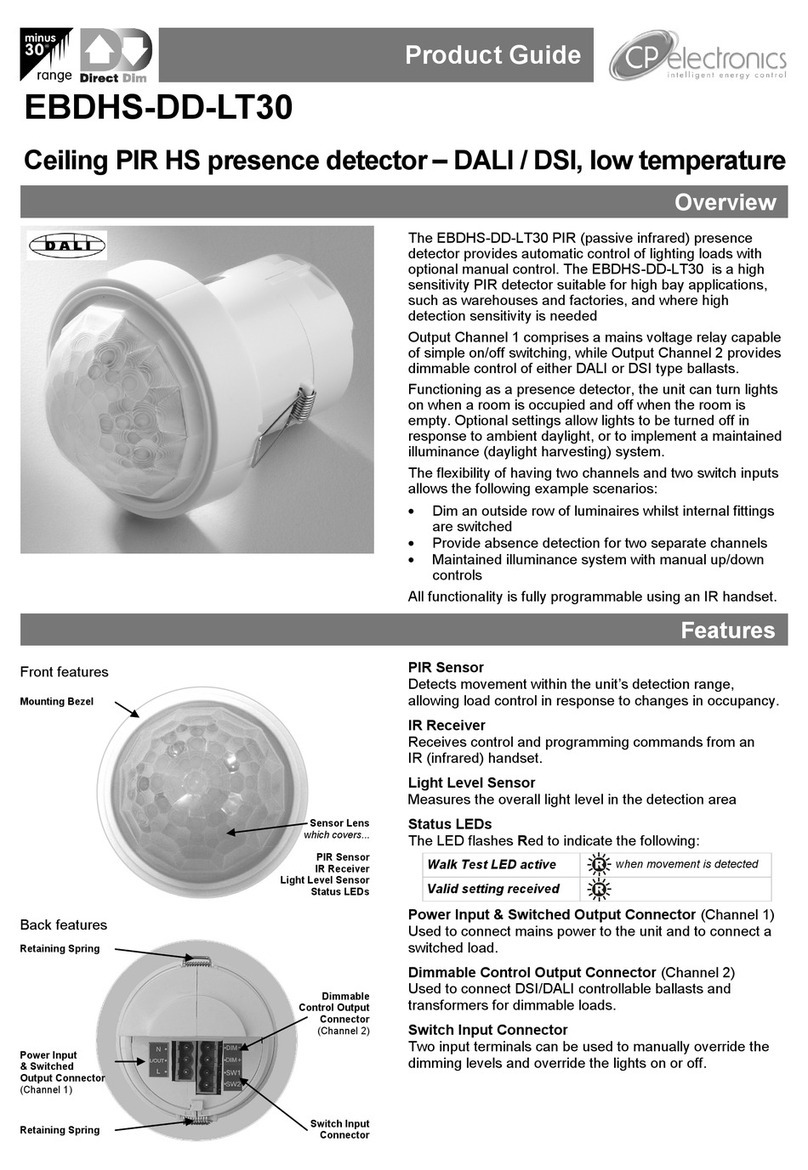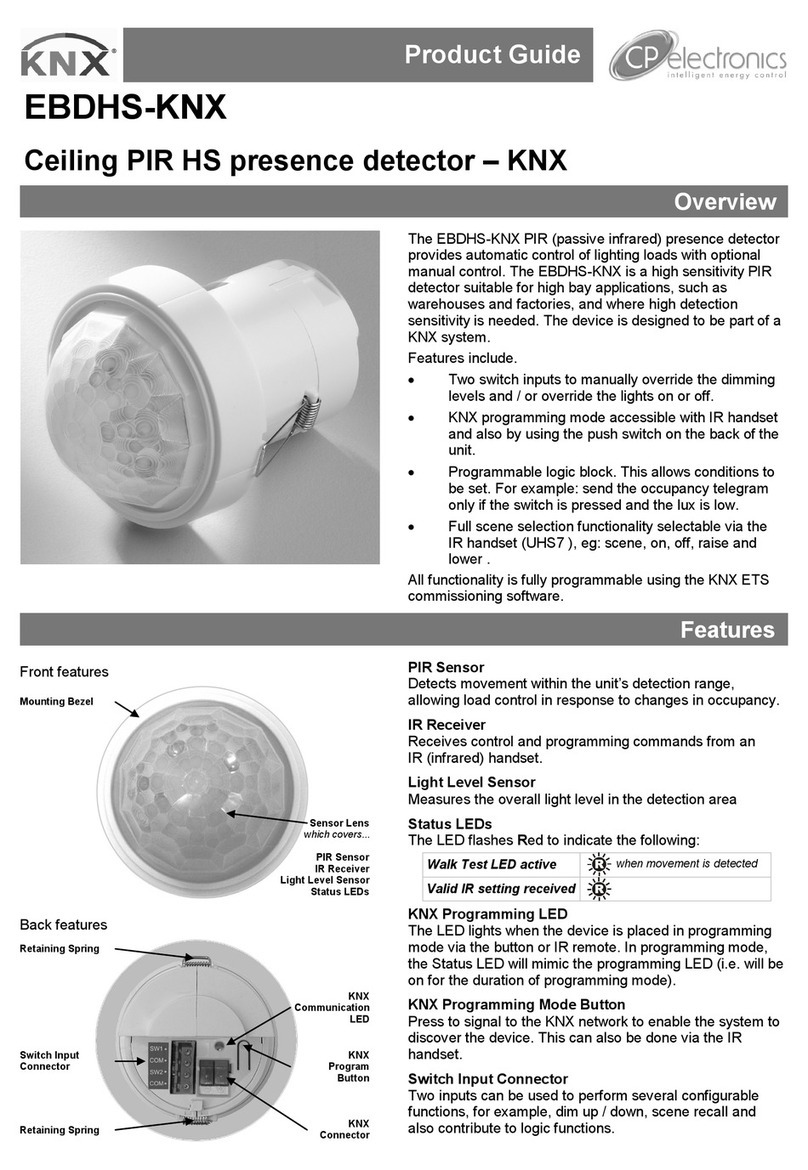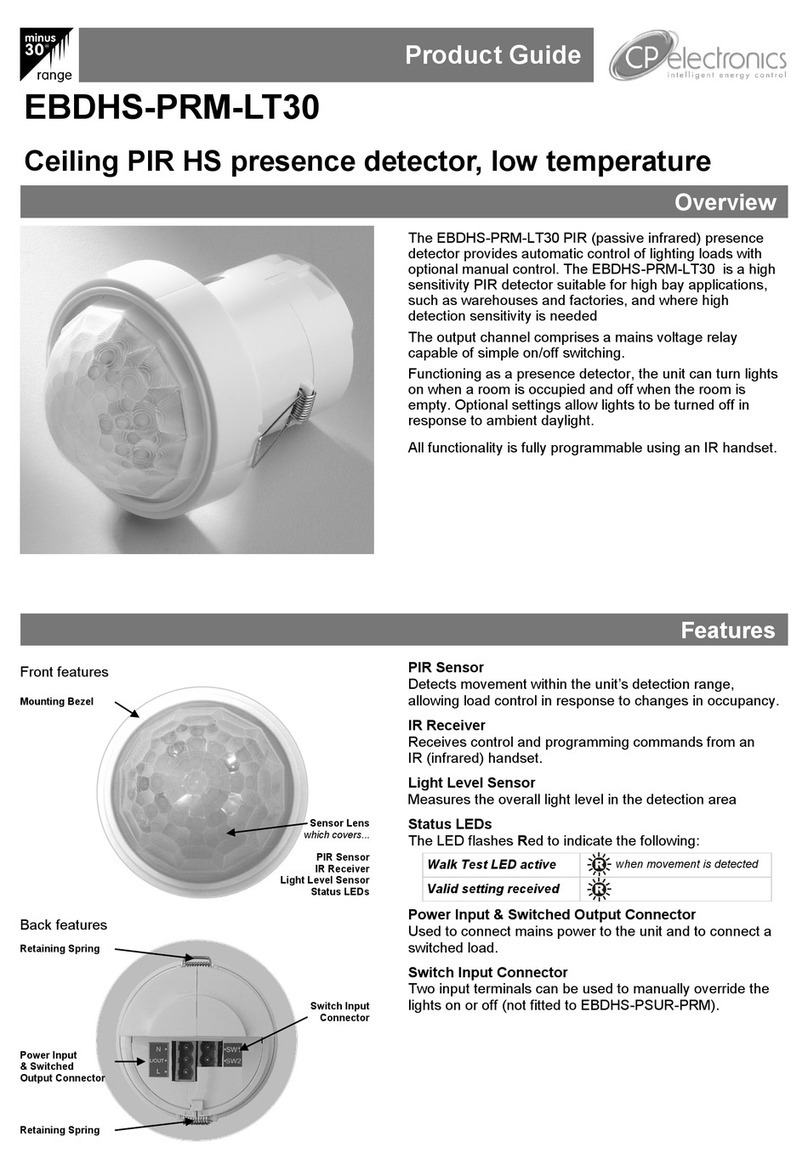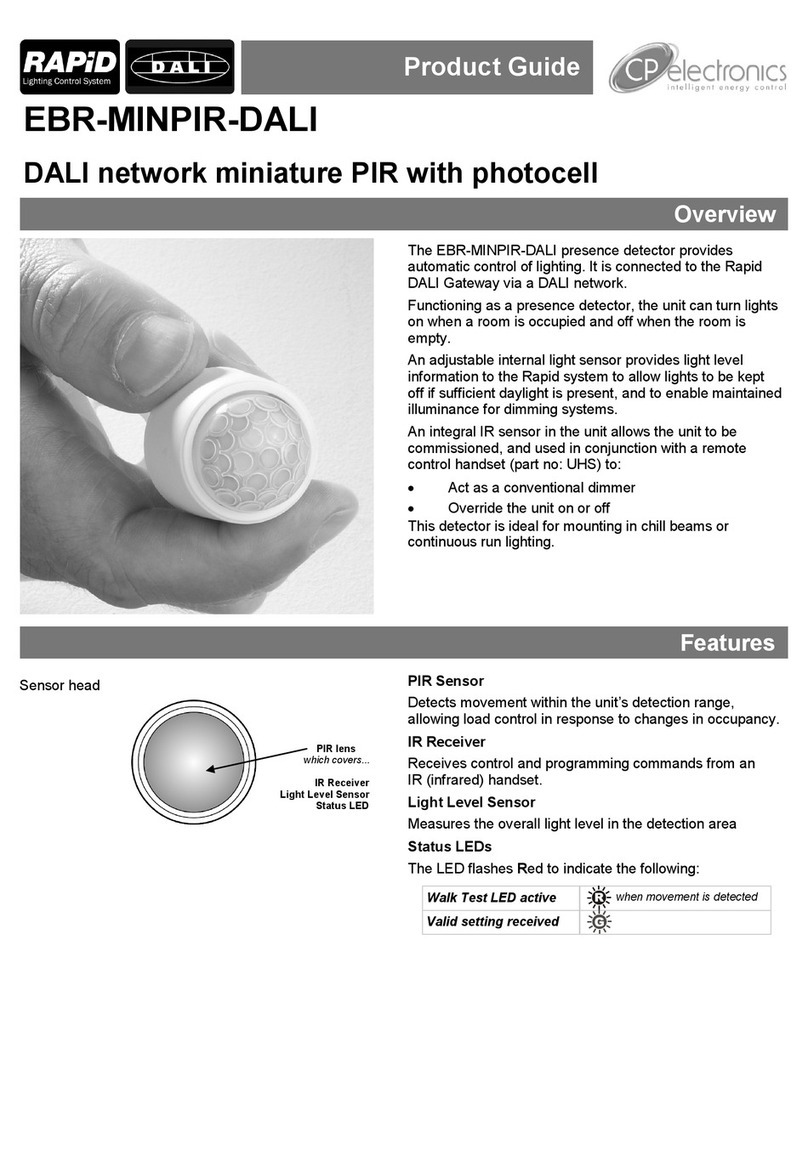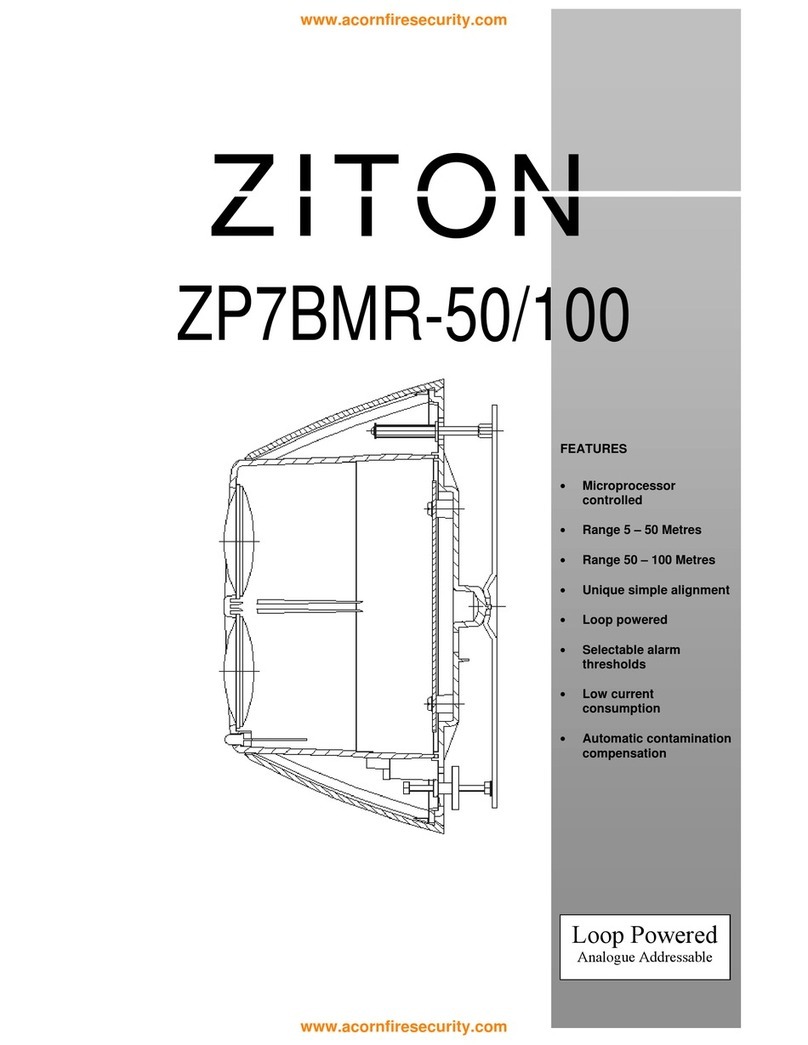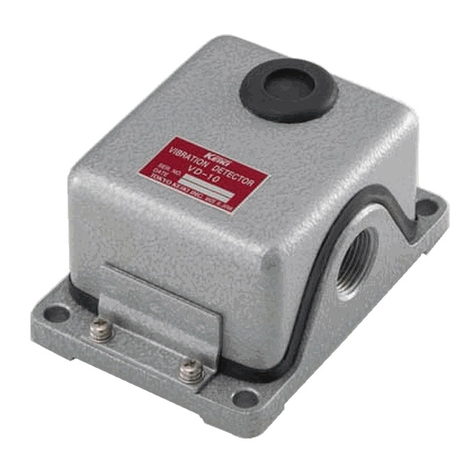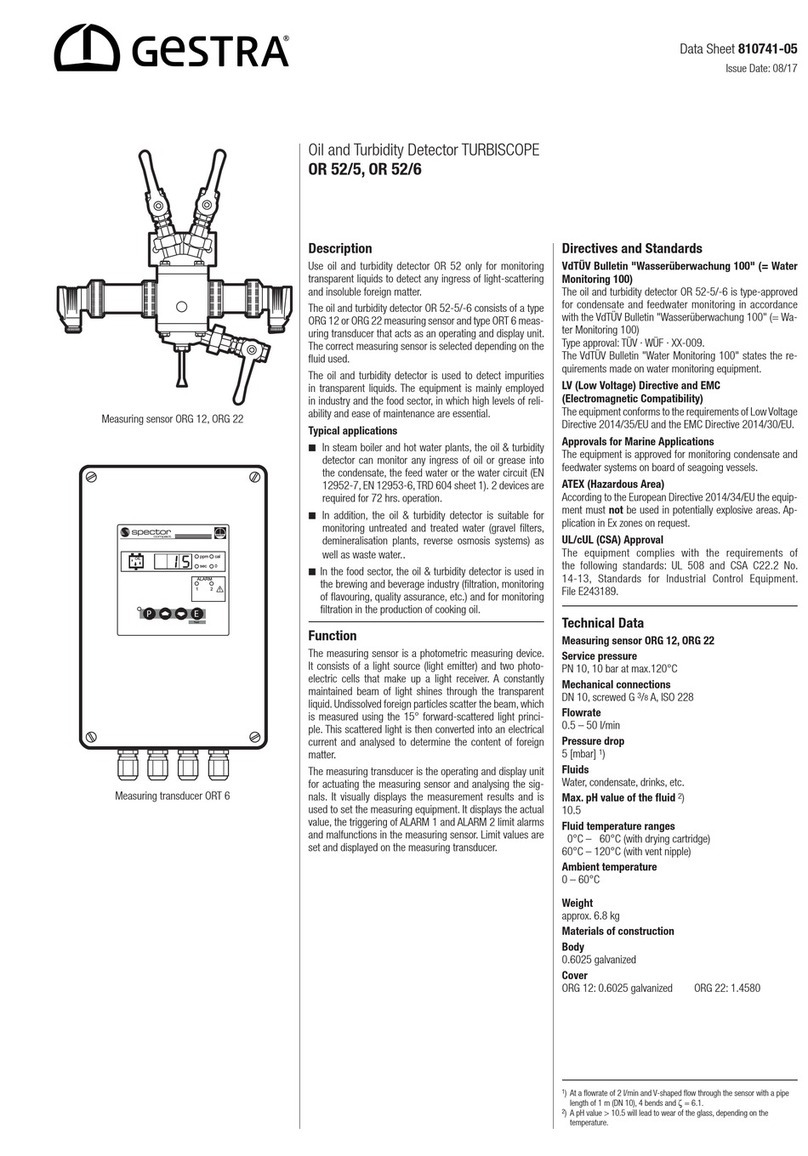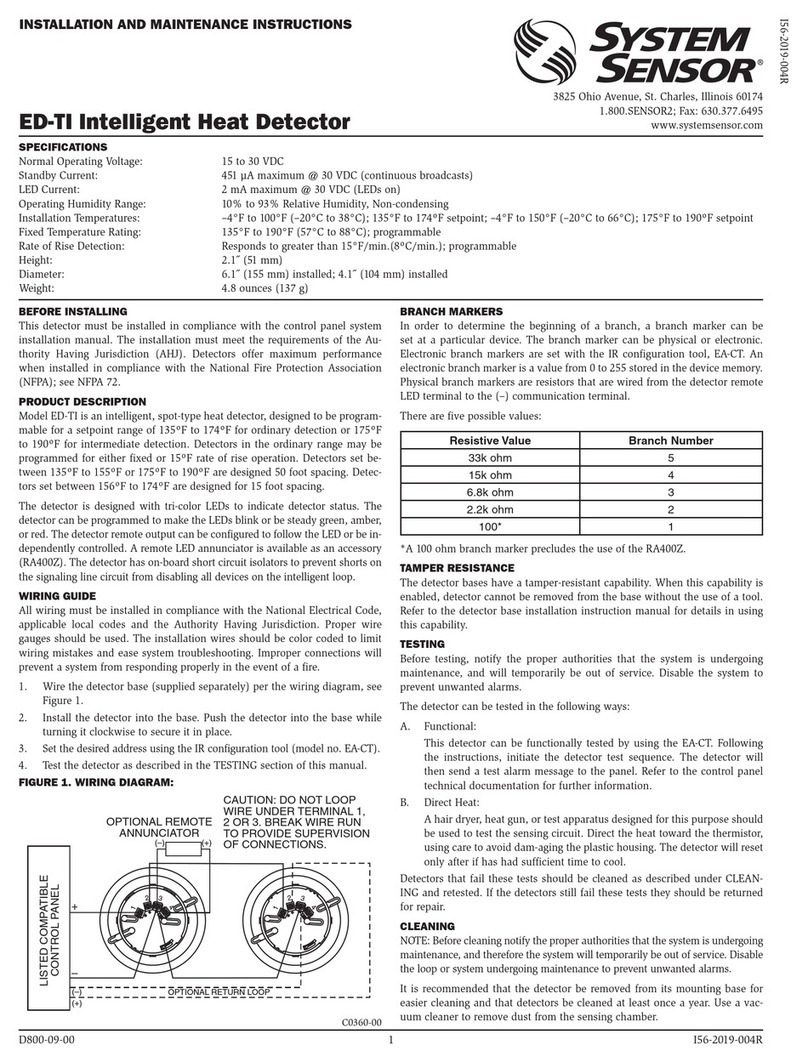CP EBDSPIR-DD-LV User manual

Overview
The EBDSPIR-DD-LV PIR (passive infrared) presence
detector provides automatic control of low voltage loads
including lighting and BMS systems with optional manual
control.
Output Channel 1 comprises a relay capable of simple on/
off switching, while Output Channel 2 provides dimmable
control of either DALI or DSI type ballasts.
Functioning as a presence detector, the unit can turn lights
on when a room is occupied and off when the room is
empty. Optional settings allow lights to be turned off in
response to ambient daylight, or to implement a maintained
illuminance (daylight harvesting) system.
The flexibility of having two channels and two switch inputs
allows the following example scenarios:
Dim an outside row of luminaires whilst internal fittings
are switched
Provide absence detection for two separate channels
Maintained illuminance system with manual up/down
controls
All functionality is fully programmable using an IR handset.
Features
Back features
Ceiling PIR presence detector - DALI / DSI 12-24V AC/DC
EBDSPIR-DD-LV
Product Guide
Retaining Spring
Retaining Spring
Power Input
& Switched
Output Connector
(Channel 1)
Dimmable
Control Output
Connector
(Channel 2)
Switch Input
Connector
PIR Sensor
Detects movement within the unit’s detection range,
allowing load control in response to changes in occupancy.
IR Receiver
Receives control and programming commands from an
IR (infrared) handset.
Light Level Sensor
Measures the overall light level in the detection area
Status LEDs
The LED flashes Red to indicate the following:
Power Input & Switched Output Connector (Channel 1)
Used to connect power to the unit and to connect a
switched load.
Dimmable Control Output Connector (Channel 2)
Used to connect DSI/DALI controllable ballasts and
transformers for dimmable loads.
Switch Input Connector
Two input terminals can be used to manually override the
dimming levels and override the lights on or off.
Walk Test LED active when movement is detected
Valid setting received
Front features
Sensor Lens
which covers...
PIR Sensor
IR Receiver
Light Level Sensor
Status LEDs
Mounting Bezel

2
Detection diagram
Area of lower sensitivityArea of high sensitivity

3
Choosing a Suitable Location
The EBDSPIR-DD-LV is designed to be ceiling mounted and must satisfy the following criteria:
Avoid positioning the unit where direct sunlight may enter the sensor element.
Do not site the sensor within 1m of any lighting, forced air heating or ventilation.
Do not fix the sensor to an unstable or vibrating surface.
Installation
Detection Mode
The Detection Mode for both output Channels 1 and 2 can be set to behave in Presence or Absence mode:
Presence When movement is detected the load will automatically turn on. When the area is no longer occupied the
load will automatically switch off after an adjustable time period.
Absence The load is manually switched on. When the area is no longer occupied the load will automatically switch
off after the adjustable time period has elapsed.
In either case, sensitivity to movement of the PIR sensor can be adjusted using the Sensitivity parameter.
HINT: To assist in setting the Sensitivity, turn on the Walk Test LED which will flash red when movement is detected.
Switch Level On/Off
Occupancy detection can be made dependant on the ambient light level using the Lux On Level and Lux Off Level
parameters.
Maintained Illuminance (daylight harvesting)
The detector measures the overall light level in the detection area and calculates the correct output for the luminaires, to
achieve a preset lux level (maintained illuminance or daylight harvesting).
Sensor functionality
Overview
It is a requirement of many fluorescent lamp manufacturers to have the lamps on at maximum output for a period of time
to guarantee lamp life (refer to the manufacturer’s datasheet for details). As this EBDSPIR-DD-LV is able to dim the
lamps using DALI/DSI, the product provides a facility to disable this for a given period of time.
Operation
By setting the “Burn in” parameter, you can select a time during which the lamps are not allowed to deviate from
maximum output. The unit counts the time, and even remembers how long has elapsed in the event of a power failure.
To cancel the burn in function, simply select a time of 0. Note that when the lamps are changed, the burn in time should
be set again.
Burn-in

4
Installation
The EBDSPIR-DD-LV is designed to be mounted using either:
Flush fixing, or
Surface fixing, using the optional Surface Mounting Box (part no. DBB).
Both methods are illustrated below.
The UNLCDHS has the ability to read back the settings stored in a device.
To read back individual parameters
Navigate to the parameter and press the ‘R’ (Read) button whilst pointing at the device. The handset will click
when the parameter has been read back, the device will flash its LED, and the value will be shown against the
parameter in the menu.
To read back all of the parameters in a menu
Press and hold the ‘R’ (Read) button for more than 1 second.
The handset will click every time a parameter is received
The device will show multiple flashes of its LED
All of the values will be shown against the parameters in the menu.
The individual parameters may be edited and then saved as a ‘Macro’.
Notes
If a parameter(s) has been missed because of a communication error, the missing value(s) is replaced by dashes.
When reading back, the Channel 1 relay (where fitted) will temporarily be switched off, and will return to it’s normal
state 2 seconds after the read back has been completed.
Readback function (UNLCDHS handset only)
Flush Fixing
Surface Fixing
1 2 3
2 3 4
1
Hole Ø64mm
Warning - be careful
bending springs when
mounting unit.
4
Pull out spring tab and rotate
spring arm as shown
50mm or 60mm fixing centres
Important
Ensure that the cables are formed as shown
before affixing the cable clamp. The clamp
MUST clamp the outer sheath(s) only.
Bend cores as shown.
Wire stripping details

5
Single channel dimming
Channel 1 (switched output) of the EBDSPIR-DD-LV
provides a switched low voltage output which can be used
to power a mains load via an auxiliary relay or for other
control purposes. The optional –Gold is used for low
current switching and the optional –OC provides an open
collector output. See diagrams below.
Channel 2 (dimmable output) of the EBDSPIR-DD-LV can
be used to control the light output of luminaires that are
fitted with dimming ballasts/transformers.
The ballasts/transformers can be connected in parallel to
Channel 2 (via the DIM–and DIM+ terminals). Refer to the
specification on page 12 for ballast quantities.
The wiring examples below show common methods of
connecting the output channels for a single detector unit.
Wiring diagrams
Functions: Switches the luminaire with occupancy and maintains illuminance. Dims and switches using optional centre
biased retractive switch (MK K4900 or similar).
Configured to presence detection: Turns on automatically with occupancy. Maintains illuminance. Press and release
down switch to turn off. Press and release up switch to turn back on. Press and hold up switch to dim up, press and hold
down switch to dim down. Turns off after occupancy.
Configured to absence detection: Press and release up switch to turn on. Maintains illuminance. Press and release
down switch to turn off. Press and hold up switch to dim up, press and hold down switch to dim down. Turns off after
occupancy.
Channel mode: Set to “Switch and dim together”.
Switch mode: Set to “2 position switch together”.
OPTION 1(B): USING A CENTRE BIASED RETRACTIVE SWITCH TO PROVIDE
ABSENCE DETECTION, WILL ALSO PROVIDE OPTIONAL OVERRIDE OFF.
OPTION 2: USING A CENTRE BIASED RETRACTIVE SWITCH TO PROVIDE
SWITCHED AND DIMMING OUTPUT (STANDARD CONFIGURATION) OPTION 3(A): USING 2 MOMENTARY PUSH TO MAKE SWITCHES TO PROVIDE SWITCHED OUTPUT TO A
NON-DIMMING LUMINAIRE AND SWITCHED / DIMMING OUTPUT TO A DIMMING LUMINAIRE OVER 2 CHANNELS
OPTION 3(B): USING A CENTRE BIASED RETRACTIVE SWITCH TO PROVIDE SWITCHED OUTPUT TO A
NON-DIMMING LUMINAIRE AND SWITCHED / DIMMING OUTPUT TO A DIMMING LUMINAIRE OVER 2 CHANNELS
6.2 Two Channel, individual switches
6.3 Two Channel, common switch
6.1 Single channel dimming
+
EBDSPIR-DD-LV SENSOR
SW1/UP
DIM+
DIM-
SW2
DOWN
DIMMING
BALLAST
DIMMING LUMINAIRE
(DSI or DALI)
CENTRE BIASED
RETRACTIVE SWITCH
Optional for presence,
mandatory for absence detection
6.4 Single channel switching
+
EBDSPIR-DD-LV SENSOR
SW1/UP
DIM+
DIM-
SW2
DOWN CENTRE BIASED
RETRACTIVE SWITCH
Optional for presence,
mandatory for absence detection
+
EBDSPIR-DD-LV SENSOR
SW1/UP
DIM+
DIM-
SW2
DOWN
DIMMING
BALLAST
DIMMING LUMINAIRE
(DSI or DALI)
CENTRE BIASED
RETRACTIVE SWITCH
Optional for presence,
mandatory for absence detection
+
EBDSPIR-DD-LV SENSOR
SW1/UP
DIM+
DIM-
SW2
DOWN
DIMMING
BALLAST
DIMMING LUMINAIRE
(DSI or DALI)
SWITCH 1 - MOMENTARY
PUSH TO MAKE SWITCH
Optional for presence,
mandatory for absence detection
SWITCH 2 - MOMENTARY
PUSH TO MAKE SWITCH
Optional for presence,
mandatory for absence detection
OUT
+
COM
LOAD INTERNAL
RELAY
LOAD CONNECTIONS
-DD-LV
-DD-LV/GOLD
OUT
+
COM
INTERNAL OPEN
COLLECTOR
TRANSISTOR
LOAD CONNECTIONS
-DD-LV/OC
LOAD
OUT
COM
AC Supply
10VAC - 26.5VAC
DC Supply
11.5VDC - 36VDC OR
-
+
OUT
COM
AC Supply
10VAC - 26.5VAC
DC Supply
11.5VDC - 36VDC OR
-
+
INPUT & SWITCH
CONNECTIONS
OUT
COM
AC Supply
10VAC - 26.5VAC
DC Supply
11.5VDC - 36VDC OR
-
+
INPUT & SWITCH
CONNECTIONS
OUT
COM
AC Supply
10VAC - 26.5VAC
DC Supply
11.5VDC - 36VDC OR
-
+
INPUT & SWITCH
CONNECTIONS
OUT
+
COM
LOAD INTERNAL
RELAY
LOAD CONNECTIONS
-DD-LV
-DD-LV/GOLD
OUT
+
COM
INTERNAL OPEN
COLLECTOR
TRANSISTOR
LOAD CONNECTIONS
-DD-LV/OC
LOAD
OUT
+
COM
LOAD INTERNAL
RELAY
LOAD CONNECTIONS
-DD-LV
-DD-LV/GOLD
OUT
+
COM
INTERNAL OPEN
COLLECTOR
TRANSISTOR
LOAD CONNECTIONS
-DD-LV/OC
LOAD
OUT
+
COM
AC Supply
10VAC - 26.5VAC
MOMENTARY PUSH TO
MAKE SWITCH
Optional for presence,
mandatory for absence detection
DC Supply
11.5VDC - 36VDC OR
-
+
INPUT & SWITCH
CONNECTIONS
OUT
+
COM
LOAD INTERNAL
RELAY
LOAD CONNECTIONS
-PRM-LV
-PRM-LV/GOLD
OUT
+
COM
INTERNAL OPEN
COLLECTOR
TRANSISTOR
LOAD CONNECTIONS
-PRM-LV/OC
LOAD
Load connections - DD-LV and DD-LV-GOLD
OUT
+
COM
AC Supply
10VAC - 26.5VAC
MOMENTARY PUSH TO
MAKE SWITCH
Optional for presence,
mandatory for absence detection
DC Supply
11.5VDC - 36VDC OR
-
+
INPUT & SWITCH
CONNECTIONS
OUT
+
COM
LOAD INTERNAL
RELAY
LOAD CONNECTIONS
-PRM-LV
-PRM-LV/GOLD
OUT
+
COM
INTERNAL OPEN
COLLECTOR
TRANSISTOR
LOAD CONNECTIONS
-PRM-LV/OC
LOAD
Load connections - DD-LV-OC

6
Two channel, individual switches
Functions: Switches both channels with occupancy. Maintains illuminance, dims and switches the dimming channel
using optional single position retractive switch (switch 2). Switches the switching channel using the optional single
position retractive switch (switch 1).
Configured to presence detection: Turns on automatically with occupancy. Maintains illuminance (dimming channel
only). Press and release switch to toggle output. Press and hold switch to dim up and down (reverses direction with
each press). Turns off after occupancy.
Configured to absence detection: Press and release switch to turn on. Maintains illuminance (dimming channel only).
Press and release switch to turn off. Press and hold switch to dim up and down (reverses direction with each press).
Turns off after occupancy.
Channel mode: Set to “Switch and dim separate”
Switch mode: Set to “1 position switch separate”
Functions: Switches both channels with occupancy. Maintains illuminance, dims and switches the dimming channel
using optional centre biased retractive switch .
Configured to presence detection: Turns on automatically with occupancy. Maintains illuminance (dimming channel
only). Press and release down switch to turn off. Press and release up switch to turn back on. Press and hold up switch
to dim up, press and hold down switch to dim down. Turns off after occupancy. Channel 1 does not operate with switch.
Configured to absence detection: Press and release up switch to turn on. Maintains illuminance (dimming channel
only). Press and release down switch to turn off. Press and hold up switch to dim up, press and hold down switch to dim
down. Turns off after occupancy. Channel 1 does not operate with switch.
Channel mode: Set to “Switch and dim separate”
Switch mode: Set to “2 position switch separate”
Two channel, common switch
OPTION 1(B): USING A CENTRE BIASED RETRACTIVE SWITCH TO PROVIDE
ABSENCE DETECTION, WILL ALSO PROVIDE OPTIONAL OVERRIDE OFF.
OPTION 2: USING A CENTRE BIASED RETRACTIVE SWITCH TO PROVIDE
SWITCHED AND DIMMING OUTPUT (STANDARD CONFIGURATION) OPTION 3(A): USING 2 MOMENTARY PUSH TO MAKE SWITCHES TO PROVIDE SWITCHED OUTPUT TO A
NON-DIMMING LUMINAIRE AND SWITCHED / DIMMING OUTPUT TO A DIMMING LUMINAIRE OVER 2 CHANNELS
OPTION 3(B): USING A CENTRE BIASED RETRACTIVE SWITCH TO PROVIDE SWITCHED OUTPUT TO A
NON-DIMMING LUMINAIRE AND SWITCHED / DIMMING OUTPUT TO A DIMMING LUMINAIRE OVER 2 CHANNELS
6.2 Two Channel, individual switches
6.3 Two Channel, common switch
6.1 Single channel dimming
+
EBDSPIR-DD-LV SENSOR
SW1/UP
DIM+
DIM-
SW2
DOWN
DIMMING
BALLAST
DIMMING LUMINAIRE
(DSI or DALI)
CENTRE BIASED
RETRACTIVE SWITCH
Optional for presence,
mandatory for absence detection
6.4 Single channel switching
+
EBDSPIR-DD-LV SENSOR
SW1/UP
DIM+
DIM-
SW2
DOWN CENTRE BIASED
RETRACTIVE SWITCH
Optional for presence,
mandatory for absence detection
+
EBDSPIR-DD-LV SENSOR
SW1/UP
DIM+
DIM-
SW2
DOWN
DIMMING
BALLAST
DIMMING LUMINAIRE
(DSI or DALI)
CENTRE BIASED
RETRACTIVE SWITCH
Optional for presence,
mandatory for absence detection
+
EBDSPIR-DD-LV SENSOR
SW1/UP
DIM+
DIM-
SW2
DOWN
DIMMING
BALLAST
DIMMING LUMINAIRE
(DSI or DALI)
SWITCH 1 - MOMENTARY
PUSH TO MAKE SWITCH
Optional for presence,
mandatory for absence detection
SWITCH 2 - MOMENTARY
PUSH TO MAKE SWITCH
Optional for presence,
mandatory for absence detection
OUT
+
COM
LOAD INTERNAL
RELAY
LOAD CONNECTIONS
-DD-LV
-DD-LV/GOLD
OUT
+
COM
INTERNAL OPEN
COLLECTOR
TRANSISTOR
LOAD CONNECTIONS
-DD-LV/OC
LOAD
OUT
COM
AC Supply
10VAC - 26.5VAC
DC Supply
11.5VDC - 36VDC OR
-
+
OUT
COM
AC Supply
10VAC - 26.5VAC
DC Supply
11.5VDC - 36VDC OR
-
+
INPUT & SWITCH
CONNECTIONS
OUT
COM
AC Supply
10VAC - 26.5VAC
DC Supply
11.5VDC - 36VDC OR
-
+
INPUT & SWITCH
CONNECTIONS
OUT
COM
AC Supply
10VAC - 26.5VAC
DC Supply
11.5VDC - 36VDC OR
-
+
INPUT & SWITCH
CONNECTIONS
OUT
+
COM
LOAD INTERNAL
RELAY
LOAD CONNECTIONS
-DD-LV
-DD-LV/GOLD
OUT
+
COM
INTERNAL OPEN
COLLECTOR
TRANSISTOR
LOAD CONNECTIONS
-DD-LV/OC
LOAD
OUT
+
COM
LOAD INTERNAL
RELAY
LOAD CONNECTIONS
-DD-LV
-DD-LV/GOLD
OUT
+
COM
INTERNAL OPEN
COLLECTOR
TRANSISTOR
LOAD CONNECTIONS
-DD-LV/OC
LOAD
OPTION 1(B): USING A CENTRE BIASED RETRACTIVE SWITCH TO PROVIDE
ABSENCE DETECTION, WILL ALSO PROVIDE OPTIONAL OVERRIDE OFF.
OPTION 2: USING A CENTRE BIASED RETRACTIVE SWITCH TO PROVIDE
SWITCHED AND DIMMING OUTPUT (STANDARD CONFIGURATION) OPTION 3(A): USING 2 MOMENTARY PUSH TO MAKE SWITCHES TO PROVIDE SWITCHED OUTPUT TO A
NON-DIMMING LUMINAIRE AND SWITCHED / DIMMING OUTPUT TO A DIMMING LUMINAIRE OVER 2 CHANNELS
OPTION 3(B): USING A CENTRE BIASED RETRACTIVE SWITCH TO PROVIDE SWITCHED OUTPUT TO A
NON-DIMMING LUMINAIRE AND SWITCHED / DIMMING OUTPUT TO A DIMMING LUMINAIRE OVER 2 CHANNELS
6.2 Two Channel, individual switches
6.3 Two Channel, common switch
6.1 Single channel dimming
+
EBDSPIR-DD-LV SENSOR
SW1/UP
DIM+
DIM-
SW2
DOWN
DIMMING
BALLAST
DIMMING LUMINAIRE
(DSI or DALI)
CENTRE BIASED
RETRACTIVE SWITCH
Optional for presence,
mandatory for absence detection
6.4 Single channel switching
+
EBDSPIR-DD-LV SENSOR
SW1/UP
DIM+
DIM-
SW2
DOWN CENTRE BIASED
RETRACTIVE SWITCH
Optional for presence,
mandatory for absence detection
+
EBDSPIR-DD-LV SENSOR
SW1/UP
DIM+
DIM-
SW2
DOWN
DIMMING
BALLAST
DIMMING LUMINAIRE
(DSI or DALI)
CENTRE BIASED
RETRACTIVE SWITCH
Optional for presence,
mandatory for absence detection
+
EBDSPIR-DD-LV SENSOR
SW1/UP
DIM+
DIM-
SW2
DOWN
DIMMING
BALLAST
DIMMING LUMINAIRE
(DSI or DALI)
SWITCH 1 - MOMENTARY
PUSH TO MAKE SWITCH
Optional for presence,
mandatory for absence detection
SWITCH 2 - MOMENTARY
PUSH TO MAKE SWITCH
Optional for presence,
mandatory for absence detection
OUT
+
COM
LOAD INTERNAL
RELAY
LOAD CONNECTIONS
-DD-LV
-DD-LV/GOLD
OUT
+
COM
INTERNAL OPEN
COLLECTOR
TRANSISTOR
LOAD CONNECTIONS
-DD-LV/OC
LOAD
OUT
COM
AC Supply
10VAC - 26.5VAC
DC Supply
11.5VDC - 36VDC OR
-
+
OUT
COM
AC Supply
10VAC - 26.5VAC
DC Supply
11.5VDC - 36VDC OR
-
+
INPUT & SWITCH
CONNECTIONS
OUT
COM
AC Supply
10VAC - 26.5VAC
DC Supply
11.5VDC - 36VDC OR
-
+
INPUT & SWITCH
CONNECTIONS
OUT
COM
AC Supply
10VAC - 26.5VAC
DC Supply
11.5VDC - 36VDC OR
-
+
INPUT & SWITCH
CONNECTIONS
OUT
+
COM
LOAD INTERNAL
RELAY
LOAD CONNECTIONS
-DD-LV
-DD-LV/GOLD
OUT
+
COM
INTERNAL OPEN
COLLECTOR
TRANSISTOR
LOAD CONNECTIONS
-DD-LV/OC
LOAD
OUT
+
COM
LOAD INTERNAL
RELAY
LOAD CONNECTIONS
-DD-LV
-DD-LV/GOLD
OUT
+
COM
INTERNAL OPEN
COLLECTOR
TRANSISTOR
LOAD CONNECTIONS
-DD-LV/OC
LOAD

7
When power is applied to the unit, the load will turn on immediately.
Set the timeout to 10 seconds, vacate the room or remain very still and wait for the load to switch off .
Check that the load switches on when movement is detected.
The unit is now ready for programming.
Power-up test procedure
What if the load does not turn ON?
Check that the supply to the circuit is good.
If the detection range is smaller than expected, check the diagram on page 2. Rotating the sensor slightly may
improve the detection range.
HINT: The Walk Test LED function can be used to check that the unit is detecting movement in the required area.
What if the load does not turn OFF?
Ensure that the area is left unoccupied for longer than the Time Out Period.
Ensure that the sensor is not adjacent to circulating air, heaters or lamps.
Fault finding

8
Basic programming
Parameter
Name
Default
Value
0123UHS5 Handset Graphics Description
Button Activation
On / Raise On Raise Turn lights on or to raise lights.
Off / Lower Off Lower Turn lights off or to lower lights.
Walk test Off On Off When set to On this causes a red LED to flash on
the sensor when it detects movement. Use this
feature to check for adequate sensitivity levels.
Time Out
(Time
adjustment)
20 mins 1, 10 &
20
minutes
5, 15 &
30
minutes
10
seconds
Once the detector is turned on, this value sets
how long the lights will stay on once movement
has ceased.
Lux on
level
(Switch
level on)
9 2, 5 & 7 4, 6 & 9 Lux level setting to prevent the luminaires being
switched on if the ambient light level is sufficient
(adjustable between 1 and 9). The luminaires will
always be switched on at level 9.
Light Level 6 (600) 2 (200)
5 (500)
7 (700)
4 (400)
6 (600)
9 (999)
Sets a target light level to be maintained by the
lighting system.
9 (999) = disabled.
Lux off
level
(Switch
level off)
9 2, 5 & 7 4, 6 & 9 Lux level setting to switch the luminaires off during
occupancy if the ambient light level goes above
the setting (adjustable between 1 and 9). Level 9
will always keep the lights on. This setting can be
used for “window row switching”.
Note: the Lux Off Level value must always be
greater than the Lux On Level value.
Load Type DALI 2-DALI
7-DSI
2-DALI
on
Sets the ballast control protocol to be used by the
output channel.
Sensitivity 9 1, 5 & 9 3, 6 & 8 Sensitivity level for detecting movement.
1 = low sensitivity
9 = high sensitivity
Defaults D Returns the unit to the default settings.
Burn-in 0 0 50 100 Determines how long the output will be at 100%
so that lamps ‘burn-in’. The ’burn-in’ time is not
affected by power supply interruptions.
Presence /
Absence
Presence Presence Absence Presence mode allows the output to turn on when
movement is detected and off when movement
ceases. Absence mode allows the output to turn
off when movement ceases, but must be manually
turned on first.
Shift Use this button to select the settings in red and
blue signified by the ‘Shift 1’ and ‘Shift 2’ LEDs
Number of Shift key presses
The functionality of the EBDSPIR-DD-LV is controlled by a number of parameters which can
be changed or programmed by any of the following devices:
UHS5 Infrared Handset. See below for programmable functions.
UNLCDHS Infrared Handset (with LCD). See user guide for full programming details.
For most basic programming operations the UHS5 handset can be used and the following procedures
are based on using this device.
Point the handset at the Sensor and send the required programming commands to the unit as shown
below.
Valid commands will be indicated by a red LED flash. See page 1 for details of other LED responses.
Note: other functions on the UHS5 which are not shown below are not applicable to this product.
SHIFT 1 SHIFT 2 SHIFT 1 SHIFT 2
SHIFT 1 SHIFT 2
SHIFT 1 SHIFT 2

9
Advanced programming
Parameter Name Default Value Range / Options Description UHS5 UNLCDHS
Detector Parameters
Walk Test LED Off On or Off When set to On this causes a red LED to flash on the sensor when it detects
movement. Use this feature to check for adequate sensitivity levels.
Time Out
(Time adjustment)
20 minutes 0-99 minutes Once the detector is turned on, this value sets how long the lights will stay on once
movement has ceased. Select 0 for 10 second delay –use for commissioning only.
Manual Time Out 10 minutes 0-99 minutes When a manual operation occurs, either via the switch input or the infrared, it
invokes the timeout period.
Example 1: a detector in presence mode has a detector timeout of 15 minutes and
a manual timeout of 3 minutes. When the user leaves the room they press the off
button. The sensor will revert to automatic after 3 minutes, and then walking back
in the room will turn the lights on.
Example 2: using the settings above, the user turns the lights off (say for a
presentation) but stays in the room. Every time a movement is detected, the
manual timeout period is re-triggered, but when it doesn’t pick up for the short
timeout period, the sensor will timeout and revert to automatic. This means the
lights may turn on inadvertently during the presentation, if the occupants are still
for the manual timeout period, so adjust the timing carefully.
Sensitivity On 9 1 (min) to 9 (max) Sensitivity level for detecting movement when the detector is already on. *UHS5
sets Sensitivity On and Off to the same value. *
Sensitivity Off 9 1 (min) to 9 (max) Sensitivity level for detecting movement when the detector is off. *UHS5 sets
Sensitivity On and Off to the same value. *
Lux time 0 0 (disabled)
1-99 minutes
If the detector measures the lux level and decides that the output needs switching
on or off as a consequence, the lux time must elapse first. If at any time during the
timed delay the lux change reverses then the process is cancelled. Lux Time
enables absence detection to be implemented with a lux off level set. When the
button is pressed, the lights will go on, regardless of ambient light level. However,
if there is sufficient ambient light, they will turn off again after the Lux Time. Note
that whenever the an external switch is pressed, whether in absence or presence
mode, if the lights were out because of the lux level, they will be immediately
turned on again for at least the Lux Time.
Power Up State On On or Off Select No for a 30 second delay on start up. If Yes is selected, there will be no
delay on start up and the detector will always power up detecting.
Disable Detector N Y or N Disables detection, leaving the relay output permanently off with the dimming
output operational. This mode is used when the unit is for maintained illuminance
only.
On Delay 0 minutes 0-99 minutes The On Delay to allows the first channel to switch on after the second channel. A
typical application for this would be where a detector is controlling lighting and air
conditioning in an area. When the occupant is detected, the lighting will be turned
on immediately, whereas the air conditioning may be turned on after 15 minutes. If
the area is vacated and the detector times out before the delay, then the air
conditioning would never go on. The delay can be set only for channel 1 using the
on delay parameter.
Inhibit 4 seconds 1 to 999 seconds When the detector turns off, a delay is instigated to prevent retriggering. In certain
circumstances this delay may not be enough. This parameter allows the delay to
be changed.
Factory default - - Restores factory default settings
Channel Modes
Switch only - - Usually used for absence detection - in this mode the dimming channel is not used.
Switch and dim
together
Default - The detector will switch and dim the lighting together.
Switch and dim
separate
- - Provides 2 channel operation –Channel 1 is switched via the relay output, and
Channel 2 is dimmed / switched via the dimming output.
User Modes
Raise - - Increase light level. Reverts when occupancy cycle complete.
Lower - - Decrease light level. Reverts when occupancy cycle complete.
Scene up - - Steps up between 6 pre-defined scenes.
Scene down - - Steps down between 6 pre-defined scenes.
Scene # - - Select the individual scene, between 0 and 6.
(1 = min. output; 2 = 10%; 3 = 25%; 4 = 50%; 5 = 75%; 6 = 100%)
Override On - - If the lights are off, sending the IR command will turn them on immediately and
revert to automatic operation using the manual timeout period.
Override Off - - If the lights are on, sending the IR command will turn them off immediately. After
the manual timeout period (described above), the sensor will revert to automatic.
Cancel - - Cancels the on or off override, returning the detector to normal operation.

10
Parameter Name Default Value Range / Options Description UHS5 UNLCDHS
Channel 1 –Switching Channel
Detection Mode Presence Presence or
Absence
Presence mode allows the output to turn on when movement is detected and off
when movement ceases. Absence mode allows the output to turn off when
movement ceases, but must be manually turned on first.
Lux on level
(Switch level on)
9 1 to 9
For a higher resolution
a scale of 101-199 is
available
Sets a minimum light level below which the PIR sensor is enabled, allowing lights
to be turned on by movement.
Note: the Lux Level Off value must always be greater than the Lux Level On value.
Lux off level
(Switch level off)
9 1 to 9
For a higher resolution
a scale of 101-199 is
available
Sets a maximum light level above which the PIR sensor is disabled, preventing
lights from being turned on by movement.
Advanced programming
Switch Modes
2 position switch
together
Default - A single centre biased retractive switch will be used to control both channels
together.
2 position switch
separate - - A single centre biased retractive switch will be used to control only the dimming
channel.
1 position switch
together - - A single position retractive switch controls both channels together.
1 position switch
separate - - Two single position retractive switches, controlling the channels separately.
Channel 2 -Dimming Channel
Detection Mode Presence Presence or
Absence
Presence mode allows the output to turn on when movement is detected and off
when movement ceases. Absence mode allows the output to turn off when
movement ceases, but must be manually turned on first.
Lux on level
(Switch level on)
9 1 to 9
For a higher resolution
a scale of 101-199 is
available
Sets a minimum light level below which the PIR sensor is enabled, allowing lights
to be turned on by movement.
Note: the Lux Level Off value must always be greater than the Lux Level On value.
Lux off level
(Switch level off)
9 1 to 9
For a higher resolution
a scale of 101-199 is
available
Sets a maximum light level above which the PIR sensor is disabled, preventing
lights from being turned on by movement.
Light Level
(maintained illuminance)
600 1 to 998 (999
disabled)
Sets a target light level to be maintained by the lighting system.
Load Type DALI DSI
DALI
DALI On
Sets the ballast control protocol to DSI.
Sets the ballast control protocol to DALI.
DALI On provides a permanent voltage to DALI ballasts when DALI has not been
implemented correctly in the ballast. Maximum number of ballasts is 5 unless the
relay is disabled then it is 10.
Max Value 100% 0 to 100% Maximum dimming output level.
Min Value 0% 0 to 100% Minimum dimming output level.
Memorise N Yes or No If this is set to Yes, the last manual lux level set will be memorised and used as the
new switch on level.
On value 99 0 to 99 Dimming output level when switched on (0-99).
Off value 0 0 to 99 Dimming output level when switched off (0-99). If a non-zero off value is set, then
the output will toggle between this value and completely off depending on the
switch level on and off values. For example, if it is light outside, the fittings will be
off if there is no occupancy. If it is dark outside, they will adopt the preset off value.
This feature is only enabled if ‘Min value’ is set to 99.
Burn-in 0 0 (disabled) or
1 to 999 hours
Determines how long the output will be at 100% so that lamps ‘burn-in’. The ’burn-
in’ time is not affected by power supply interruptions.
Fade value 10 0 to 99 After occupancy ceases, this dimming output level is loaded for the fade time
(adjustable between 0 and 99).
Fade mins 0 0 to 99 This is the time period (adjustable between 0 and 99 minutes) that the luminaire
will be held at the fade value before turning off. A value of 0 disables the fade
function.
Speed On 40 Measured in 0.1
sec intervals.
Determines the dimming response speed after the setup time has finished.
Speed Set 5 Measured in 0.1
sec intervals.
Determines the dimming response speed during the set up time. Measured in 0.1
sec intervals. If set to 0 will disable dimming for “Set seconds” below, used if
fittings are required to warm up before dimming.
Set Seconds 120 1 to 999 seconds Determines how long the dimming response set-up period lasts on power-up or on
setting change. This enables the desired lux level to be achieved rapidly when the
lights come on, or during setup.

11
This page intentionally left blank

12
Due to our policy of continual product improvement CP Electronics reserves the right to alter the specification of this product without prior notice.
Dimensions See diagrams opposite
Weight 0.15kg
Supply Voltage Min 11.5VDC max 36VDC, min
10VAC max 26.5VAC
Maximum Load Channel 1 (switching):
EBDSPIR-DD-LV
Low voltage supply with relay
output rating 16A resistive 10A
inductive
EBDSPIR-DD-LV-GOLD
Low voltage with relay contact for
low on resistance suitable for
control wire applications 3A
resistive load. Not suitable for
inductive loads
EBDSPIR-DD-LV-OC
Low voltage supply with open
collector output, rating 50mA,
30VDC max
Channel 2 (dimming):
Maximum number of DSI or DALI
ballasts is 10 unless the relay is
disabled then it is 20.
Power consumption On 627mW, Off 257mW
Dimming output Basic insulation only. Although low
voltage, this is not an SELV output
and should be treated as if mains
potential. Use mains rated wiring.
Terminal Capacity 2.5mm2
Temperature -10ºC to 35ºC
Humidity 5 to 95% non-condensing
Material (casing) Flame retardant ABS and PC/ABS
Type Class 2
IP rating IP40
Compliance EMC-2004/108/EC
LVD-2006/95/EC
Technical data
Part numbers
C.P. Electronics Ltd
Brent Crescent
London
NW10 7XR
United Kingdom
Tel: + 44 (0) 333 900 0671
Fax: + 44 (0) 333 900 0674
www.cpelectronics.co.uk
enquiry@cpelectronics.co.uk
Ref: #WD488 Issue 3
IMPORTANT NOTICE!
This device should be installed by a qualified electrician in
accordance with the latest edition of the IEE Wiring
Regulations and any applicable Building Regulations.
EBDSPIR-DD-LV
DBB
Part number Description
Detector EBDSPIR-DD-LV Ceiling PIR presence/absence detector 12-24V AC/DC
EBDSPIR-DD-LV-GOLD Ceiling PIR presence/absence detector 12-24V AC/DC for low current
EBDSPIR-DD-LV-OC Ceiling PIR presence/absence detector 12-24V AC/DC + open collector output
Accessories DBB Surface mounting box
UHS5 Programming IR handset
UNLCDHS Universal LCD IR handset
Table of contents
Other CP Security Sensor manuals
Popular Security Sensor manuals by other brands
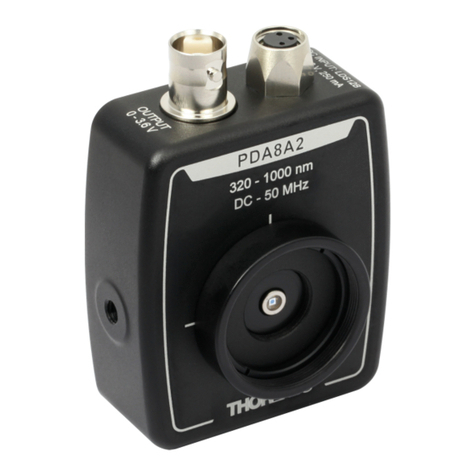
THORLABS
THORLABS PDA8A2 quick reference

heightec
heightec TowerPack WK34 User instructions
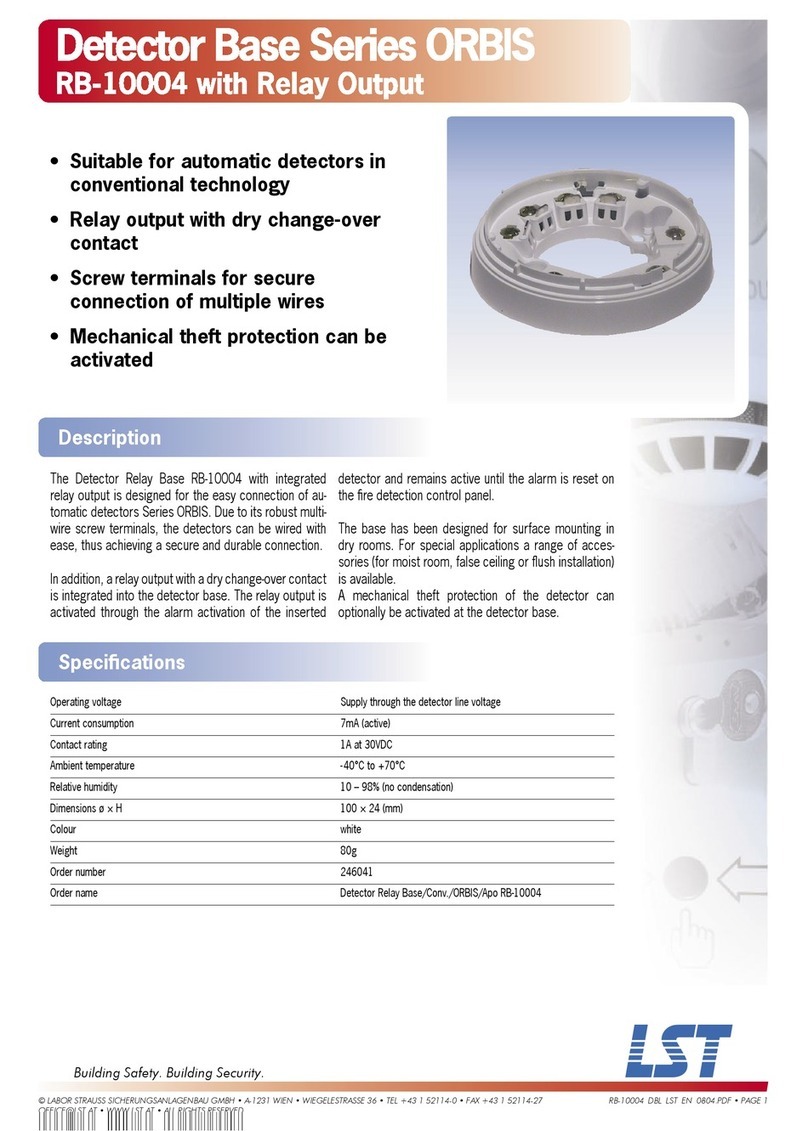
LST
LST Orbis RB-10004 Specifications
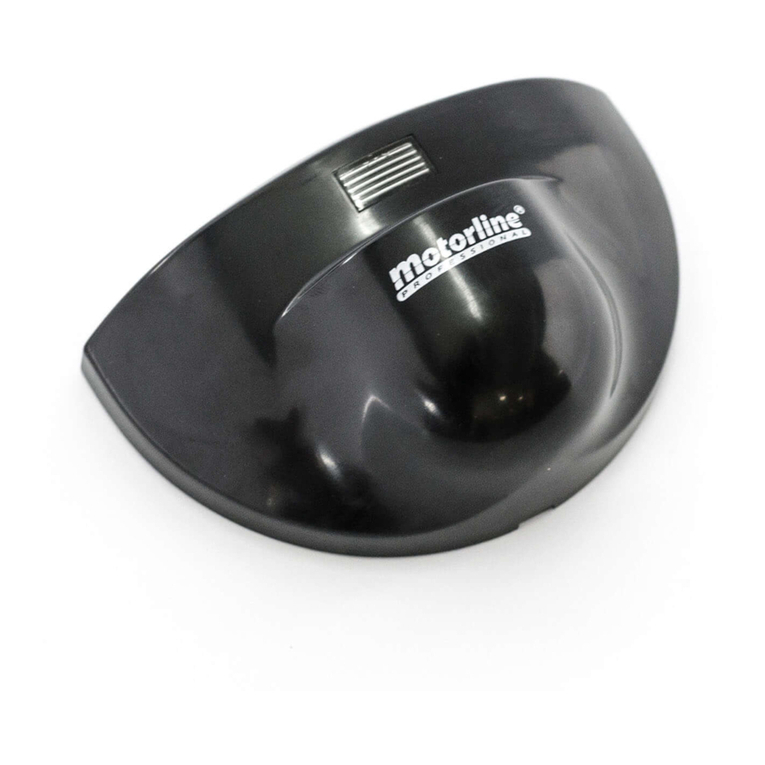
Motorline professional
Motorline professional M1601 User's and installer's manual
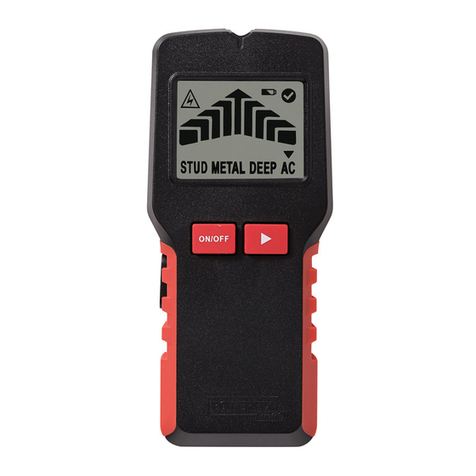
Powerfix Profi
Powerfix Profi 4-IN-1 MULTI-DETECTOR Operation and safety notes

DÖRR
DÖRR FB-300 instruction manual
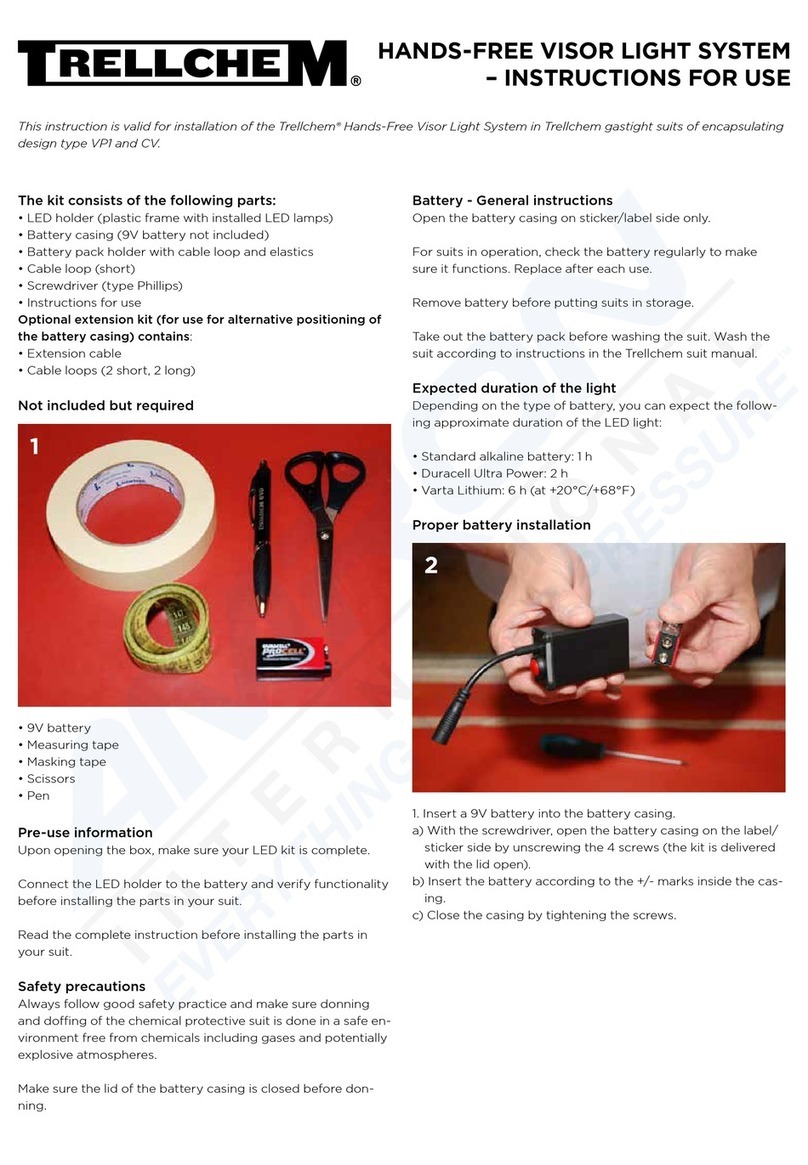
Ansell
Ansell Trellchem Hands-Free Visor Light System Instructions for use

SubSurface Leak Detection
SubSurface Leak Detection LD-12 Professional's Plus operating instructions

PCB
PCB Load & Torque 4115K-13A Installation and operating manual

SEW-Eurodrive
SEW-Eurodrive MOVIFIT FC manual
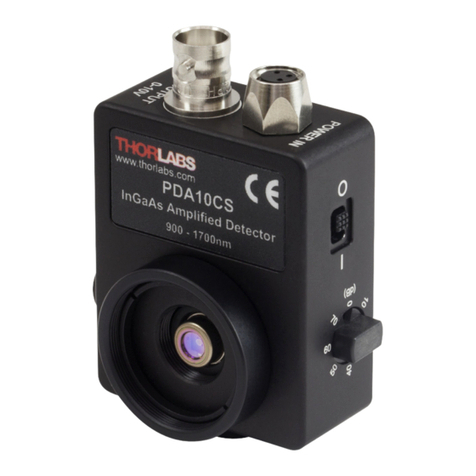
THORLABS
THORLABS PDA10CS user guide
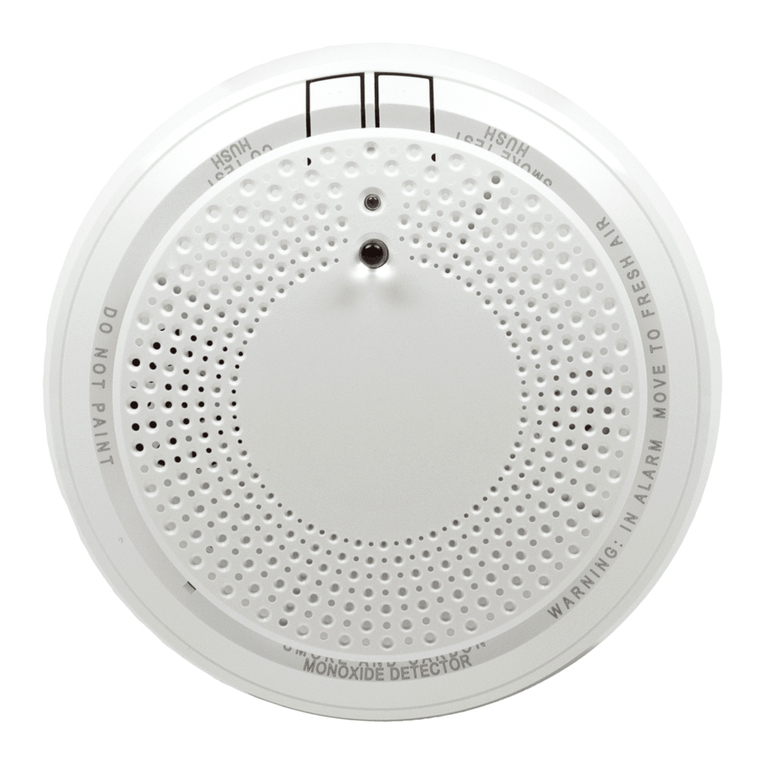
Honeywell Home
Honeywell Home PROSiXCOMBO Installation and setup guide
